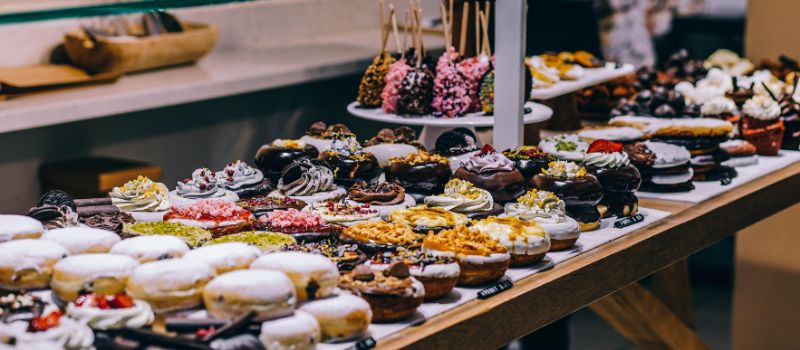Tax Rules for Candy
In Chicago, how candy is taxed depends on its ingredients:
- Candy with flour (e.g., chocolates, ice cream):
These are classified as “food” and are taxed at the standard food rate. - Candy without flour (e.g., hard candies, suckers):
These are classified as “candy” and are taxed an additional 5.25% merchandise rate
Note: A similar distinction applies to soft drinks.
The level of soy, milk, or fruit juice in a beverage can determine whether it is taxed at the food rate or with an added 5.25% merchandise tax
Bakery Exceptions
Clarification from the Illinois Department of Revenue
The Department has issued a letter ruling on how bakeries should apply tax rates when:
- They sell both ready-to-eat items and grocery-type items, and
- Provide facilities for on-premises consumption

Conditions for Applying Lower Tax Rate
Bakery items may be taxed at the lower food rate if both of the following conditions are met:
- Physical Separation of Areas
- The area for on-premises consumption must be physically separated or distinguishable from the area where non-immediate consumption items are sold
- Definition of “Physically Separated”:
- Tangible barrier
- Arrangement of display cases, service counters, or stub walls
- Any setup that creates a partially isolated eat-in area
- Separate Recording and Accounting Systems
- This includes:
- Cash registers that separately identify high-rate and low-rate sales
- Separate cash registers
- Any system that records the different tax rates at the time of collection
- This includes:
Frequently Asked Questions
What determines if candy is taxed at a higher rate in Chicago?
Candy is taxed based on its ingredients. If it contains flour, like certain chocolates or ice cream, it qualifies as “food” and is taxed at the lower food rate. Candy without flour, such as hard candies or suckers, is taxed an additional 5.25% at the merchandise rate.
How does the tax apply to soft drinks in Illinois?
Soft drinks are taxed similarly to candy. If a beverage contains enough soy, milk, or fruit juice, it may qualify for the lower food rate. Otherwise, it is subject to an additional 5.25% merchandise tax.
Can bakeries charge the lower food tax rate for all items?
No. Bakeries can only apply the lower food tax rate if they sell items for off-premises consumption and meet specific requirements, including physically separating dine-in areas and using separate accounting systems.
What does “physically separated” mean for bakery dining areas?
Physically separated means there is a tangible or visual barrier, such as display cases, counters, stub walls, or similar setups, that distinguishes the eat-in area from areas where food is sold for off-site consumption.
What kind of accounting systems must bakeries use to qualify for lower tax rates?
Bakeries must use separate systems for recording sales subject to different tax rates. This includes separate cash registers or systems that clearly identify whether a sale is taxed at the higher or lower rate at the point of collection.

